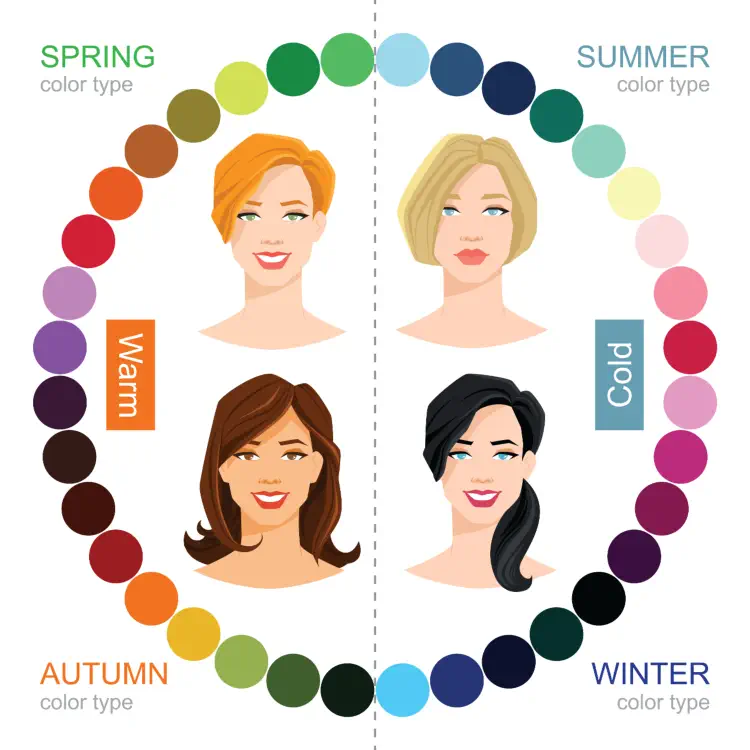Do you know your basic seasonal color type?
If you are not sure which basic seasonal color type you are, please book my online course “DIY Seasonal Color Analysis.
Yours Melanie
The seasonal color theory
The colour type theory uses skin tone, eye and hair color to determine colors for clothing and make-up that should harmonize particularly well with the respective type. If you know your color type, you are guaranteed to always have something in your closet that you like to wear. If you pay attention to your color type when shopping, you can save a lot of time when choosing and the clothes can be combined with each other much better – which saves money. And the best thing is: colors that suit your type make you shine and show you from your best side!
The basic classification is based on a certain order of the criteria “temperature”, “saturation” and “brightness” in the four seasons spring, fall, summer and winter. The most important criterion here is temperature (warm or cold), followed by saturation (clear or muted/soft) and brightness (light or dark). For very few people, the 4-color system is sufficient, as brightness or saturation can be more important than temperature if the temperature is more neutral. This is where the 12 Seasonal Color System comes into play, which you can access here if you already know your basic season or are having difficulty finding it.
Find out your basic seasonal color type
It is usually easier to find out which of the 4 basic season types you belong to first. Is the basic tone of your skin rather cool (bluish or olive) or warm (yellowish/golden or peach-colored)? Uncertain about your undertone? Hold gold and silver jewelry against your face. If gold enhances your complexion and brightens your eyes while silver appears dull, your undertone is warm, aligning with spring or autumn. Conversely, if silver complements you and gold doesn’t, your undertone is cool, indicating summer or winter.
The second step is to determine whether you are a darker or lighter type. If your hair is blonde or reddish blonde to light brown and your eyes are blue, green or amber, you belong to the light type found in spring or summer. Dark hair colors from chestnut brown to black and amber to dark brown eyes, which can also be green-blue, grey-blue or deep blue, characterize the dark type, which is found in autumn or winter. Please note that the attributes listed here are very general. For example, you can also be a winter type with light brown or blonde hair if your other attributes are appropriate. To find out more, take a look at my online course.
The 4 basic seasonal color types
- Spring: warm and light
- Summer: cool and light
- Autumn: warm and dark
- Winter: cool and dark

Spring
As you already know, you are a spring type if your skin has a warm undertone and your hair and eyes are light. Your hair shimmers golden in the sun. If you have freckles, they will also be golden. Eye colors range from golden-green to yellow-turquoise to amber or even brown. You are flattered by clear, warm colors that are fresh and bright, but never muted or dark. For a more precise definition, click here for the 3 color types of spring.
Summer
Does your skin have a cool undertone and your hair and eyes are rather light? You are almost certainly a summer type if your hair has an ash tone (ash blonde, ash brown) or is light to medium brown and your eyes are a lighter blue, blue-grey, gray-green or aquamarine. Your skin can appear rosy but not in the warm range. Your colors are cool, muted and with a blue undertone. Orange does not usually suit the summer type. For a more precise determination, click here for the 3 color types of summer.
Autumn
If your skin has a warm undertone, but your hair and eyes are rather dark compared to the spring type, you belong to the fall type. Autumn hair colors cover the entire brown palette from reddish brown to light/honey brown to dark brown. However, it can also be a soft golden blonde. The eyes are usually brown in all shades up to almost black, but also olive green, petrol or green-turquoise and blue mixed. Freckles are often present. The colors of autumn are warm, muted, never bright and appear earthy and deep. For a more precise definition, click here for the 3 color types of autumn.
Winter
Winter types are characterized by a cool undertone to the skin and dark hair. There are usually great contrasts between skin, hair and eyes. The skin often has an olive tone (regardless of whether the skin is light or dark) – these types tan quickly and deeply – or white skin that does not tan or hardly tans at all (Snow White type). The hair is usually dark brown or black, the eye colors cover all variations of blue and brown. Here, too, there is a great contrast between the iris and the whites of the eyes. Very rarely the hair is white blonde. The colors of winter are clear, cold and bright, with a blue undertone. Black and white suit the winter type very well, as does a certain bright red. For a more precise definition, click here for the 3 color types of winter.
More precise determination with the 12-Color-System
It’s easier to determine your color type if you know how the 12-color system works. Find out more about it here.